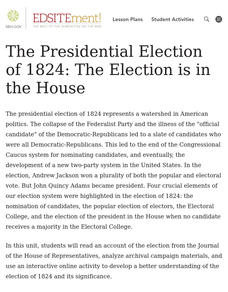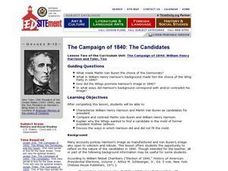Curated OER
The Election Is in the House: Was There a Corrupt Bargain?
Students take a stand, supported by evidence, on whether there was a "corrupt bargain" between Henry Clay and John Quincy Adams.
Curated OER
The Election Is in the House: The Presidential Election of 1824
Students read an account of the election from the Journal of the House of Representatives, analyze archival campaign materials, and use an interactive online activity to develop a better understanding of the election of 1824 and its...
Curated OER
The Campaign of 1840: William Henry Harrison and Tyler, Too
Students list some issues important during the campaign of 1840. They compare and contrast the careers of Martin Van Buren and William Henry Harrison before they became president and explain why the Whigs wanted to find a candidate in...
National Endowment for the Humanities
The 1828 Campaign of Andrew Jackson: Expansion of the Voting Base
Students give examples to indicate how the franchise was extended and limited in the first half of the 19th century, and cite some differences in the newly enfranchised population that could affect the way they would vote.
Curated OER
The Campaign of 1840: The Candidates
Students compare and contrast William Henry Harrison and Martin Van Buren as candidates for president. They explain why the Whigs wanted to find a candidate in the mold of former president Andrew Jackson and discuss whether Harrison fit...
Curated OER
The Campaign of 1840: The Campaign
Students discuss the use of visual images, objects, and spectacle in the 1840 campaign, then take a stand: Was the campaign of 1840 based more on substance or image?
Curated OER
The Campaign of 1840: The Whigs, the Democrats, and the Issues
Students reflect on the nature of the campaign of 1840. They identify the positions of the Democrats and the Whigs and their basic differences.








